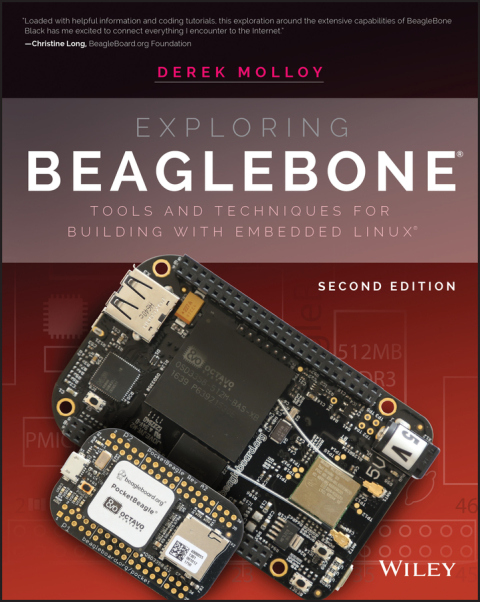Description
Efnisyfirlit
- Cover
- Introduction
- Why the BeagleBone and PocketBeagle?
- How This Book Is Structured
- Conventions Used in This Book
- What You’ll Need
- Errata
- Digital Content and Source Code
- Part I: Beagle Board Basics
- CHAPTER 1: The Beagle Hardware Platform
- Introduction to the Boards
- BeagleBone Documentation
- The Beagle Hardware
- Beagle Accessories
- Capes
- How to Destroy Your Board!
- Summary
- Support
- Notes
- CHAPTER 2: Beagle Software
- Linux on the Beagle Boards
- Communicating with the Boards
- Controlling the Beagle Board
- Node.js, Cloud9, and BoneScript
- Summary
- Further Reading
- Notes
- CHAPTER 3: Exploring Embedded Linux Systems
- Introducing Embedded Linux
- Managing Linux Systems
- Using Git for Version Control
- Desktop Virtualization
- Code for This Book
- Summary
- Further Reading
- Bibliography
- Notes
- CHAPTER 4: Interfacing Electronics
- Analyzing Your Circuits
- Basic Circuit Principles
- Discrete Components
- Logic Gates
- Analog-to-Digital Conversion
- Concluding Advice
- Summary
- Further Reading
- Note
- CHAPTER 5: Practical Beagle Board Programming
- Introduction
- Scripting Languages
- Dynamically Compiled Languages
- C and C++ on the Beagle Boards
- Overview of Object-Oriented Programming
- Interfacing to the Linux OS
- Improving the Performance of Python
- Summary
- Further Reading
- Bibliography
- Notes
- Part II: Interfacing, Controlling, and Communicating
- CHAPTER 6: Interfacing to the Beagle Board Input/Outputs
- General-Purpose Input/Outputs
- The Linux Device Tree
- Analog Inputs and Outputs
- BoneScript
- Advanced GPIO Topics
- Summary
- Further Reading
- Notes
- CHAPTER 7: Cross-Compilation, Eclipse, and Building Linux
- Setting Up a Cross-Compilation Toolchain
- Cross-Compilation Using Eclipse
- Cross-Building Linux
- Summary
- Notes
- CHAPTER 8: Interfacing to the Beagle Board Buses
- Introduction to Bus Communication
- IC
- SPI
- UART
- CAN Bus
- Logic-Level Translation
- Summary
- Further Reading
- Notes
- CHAPTER 9: Interacting with the Physical Environment
- Interfacing to Actuators
- Interfacing to Analog Sensors
- Interfacing to Local Displays
- Building C/C++ Libraries
- Summary
- Further Reading
- Notes
- CHAPTER 10: Real-Time Interfacing Using External Slave Processors
- Real-Time Beagle Board
- Extended GPIO Availability
- Adding External UARTs
- The Arduino
- Summary
- Further Reading
- Notes
- Part III: Advanced Beagle Board Systems
- CHAPTER 11: The Internet of Things
- The Internet of Things
- A Beagle Board IoT Sensor
- The Beagle Board as a Sensor Web Server
- A C/C++ Web Client
- A Beagle Board as a “Thing”
- IoT Frameworks
- The C++ Client/Server
- IoT Device Management
- Summary
- Notes
- CHAPTER 12: Wireless Communication and Control
- Introduction to Wireless Communications
- Bluetooth Communications
- Wi-Fi Communications
- ZigBee Communications
- Near Field Communication
- Summary
- Notes
- CHAPTER 13: Beagle Board with a Rich User Interface
- Rich UI Beagle Board Architectures
- Rich UI Application Development
- Qt Primer
- Remote UI Application Development
- Summary
- Further Reading
- Notes
- CHAPTER 14: Images, Video, and Audio
- Capturing Images and Video
- Streaming Video
- Image Processing and Computer Vision
- BeagleBone Audio
- Summary
- Further Reading
- CHAPTER 15: Real-Time Interfacing with the PRU-ICSS
- The PRU-ICSS
- Development Tools for the PRU-ICSS
- Using the AM335x PRU-ICSS
- A First PRU Example
- The PRU-ICSS in Detail
- PRU-ICSS Applications
- Summary
- Further Reading
- CHAPTER 16: Embedded Kernel Programming
- Introduction
- A First LKM Example
- An Embedded LKM Example
- Enhanced Button GPIO Driver LKM
- Enhanced LED GPIO Driver LKM
- Conclusions
- Summary
- Note
- Index
- End User License Agreement







Reviews
There are no reviews yet.